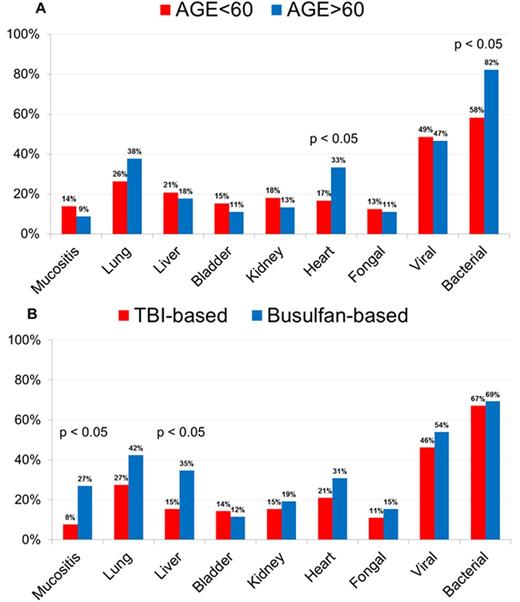Abstract
T-replete Haplo-HSCT is presently a major evolution in the field of allo-HSCT. Despite we miss prospective evaluation, we are faced to a high pace of diffusion worldwide. We however need to collect informations on many aspects. In this abstract we report an analysis of the early events and organ toxicities in the first patients transplanted in our program. Between 2011 and 2015, 117 patients treated for hematologic malignancy, receiving a Haplo-HSCT and post-transplant high dose cyclophosphamide (PT-HDCY) with a minimal follow-up of 100 days were analyzed. All organ toxicities were graded according to WHO scale and only grade 3-4 toxicities were analyzed: impact of age, Hematopoietic transplant comorbidity index (HCT-CI) and conditioning regimen were analyzed in this first step evaluation. Median age was 56 (19-73) and 58% were males (M/M: 35%; M/F: 21%; F/M: 23%; F/F: 21%; Donor origin: Sibling: 43%; offspring: 45%; Mother: 9%; Father: 3%). Patients were transplanted for: Acute Leukemia (AL): 32%; Non-AL myeloid malignancies: 19%; Lymphoma: 36%; Non-lymphoma Lymphoid malignancies: 13%. Patients were at high risk of both relapse (48% of active disease at the time of Haplo-HSCT, Disease risk index: low: 8%; Intermediate: 59%; high/very high: 33%) and non-relapse mortality [NRM] (65% had HCT-CI of 3 or more). Conditioning regimens were non-myeloablative TBI-based (NMAC), busulfan-based reduced intensity (RIC) and busulfan-based myeloablative conditioning (MAC) in 68%, 10% and 22%, respectively. PBSC were infused in 89% of the patients. Graft CD34/CD3 cells: 5.2 (0,8-14,8) / 261 (27-629) x 10e6/kg. Seventeen (15%) pts received a previous allo-HSCT and 7 (6%) pts with AL were included in a sequential debulking-transplant strategy.
One-year overall survival, PFS and GRFS were 85%, 78% and 55%.
Graft failure occurred in 3 pts (all with positive donor specific antibodies). Others reached ANC>0.5 G/L and platelet count>20G/L in a median time of 20 (14-38) and 31 (10-395) days post Haplo-HSCT. Day-100 cumulative incidence of grade 2-4 and 3-4 acute GVHD were 24% and 7%, respectively. Grade 3-4 WHO toxicities within 100 days: Pulmonary: 31%; Cardiac: 23%; Liver: 20%; Cystitis: 14%; mucositis: 12%; renal: 8%.
14 patients (12%) died within 100 days at a median of 40 (2-84) days (9 (9%) of the 100 patients with first and 5 (29%) of 17 patients with previous allo-HSCT). Causes of NRM were (n patients): infection: 6; Cardiac: 4; GVHD: 2; Neurologic: 2. In a multivariate analysis, grade 3-4 3-4 OMS cardiac toxicity occurred more frequently in pts older than 60 (HR: 0.42 (0.17-1.0), p=0.05, Figure 1A) and both oral mucositis (HR: 0.22 (0.06-0.72), p=0.01) and liver toxicity (HR: 0.32 (0.12-0.89), p=0.03) in patients treated with busulfan-based conditioning (Figure 1B). Seventy-nine (68%) patients experienced bacterial infection, 56 (48%) viral reactivation and 14 (12%) fungal infections. Pts older than 60 experienced more frequent bacterial infection than others (82% vs 58%: p=0.01, Figure 1A).
In conclusion, this retrospective analysis suggests a higher incidence of peculiar organ toxicity as cardiac and bladder deserving further analysis. It also suggests that in a high-risk population (second allo-HSCT:15%; patients over 60 years: 38%; HCT-CI≥3: 65%; High/Very high DRI: 33%; transplanted with active disease: 48%early NRM is somehow limited allowing further development at the condition to take into account the main factors leading to these toxicities and to develop adapted care.
No relevant conflicts of interest to declare.
Author notes
Asterisk with author names denotes non-ASH members.


This feature is available to Subscribers Only
Sign In or Create an Account Close Modal